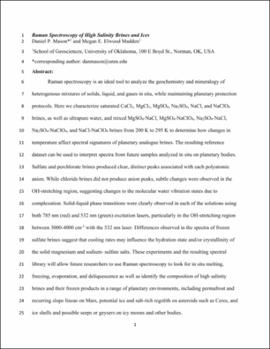| dc.description.abstract | Raman spectroscopy is an ideal tool to analyze the geochemistry and mineralogy of heterogenous mixtures of solids, liquid, and gases in situ, while maintaining planetary protection protocols. Here we characterize saturated CaCl2, MgCl2, MgSO4, Na2SO4, NaCl, and NaClO4 brines, as well as ultrapure water, and mixed MgSO4-NaCl, MgSO4-NaClO4, Na2SO4-NaCl, Na2SO4-NaClO4, and NaCl-NaClO4 brines from 200 K to 295 K to determine how changes in temperature affect spectral signatures of planetary analogue brines. The resulting reference dataset can be used to interpret spectra from future samples analyzed in situ on planetary bodies. Sulfate and perchlorate brines produced clear, distinct peaks associated with each polyatomic anion. While chloride brines did not produce anion peaks, subtle changes were observed in the OH-stretching region, suggesting changes to the molecular water vibration states due to complexation. Solid-liquid phase transitions were clearly observed in each of the solutions using both 785 nm (red) and 532 nm (green) excitation lasers, particularly in the OH-stretching region between 3000-4000 cm-1 with the 532 nm laser. Differences observed in the spectra of frozen sulfate brines suggest that cooling rates may influence the hydration state and/or crystallinity of the solid magnesium and sodium- sulfate salts. These experiments and the resulting spectral library will allow future researchers to use Raman spectroscopy to look for in situ melting, freezing, evaporation, and deliquescence as well as identify the composition of high salinity brines and their frozen products in a range of planetary environments, including permafrost and recurring slope lineae on Mars, potential ice and salt-rich regolith on asteroids such as Ceres, and ice shells and possible seeps or geysers on icy moons and other bodies. | en_US |

